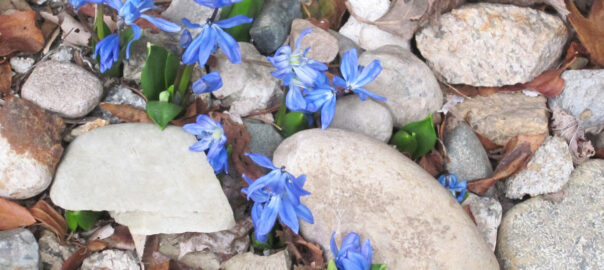
The pretty blue flowers of the Siberian squills (Scilla siberica) are always a welcome sight to me at this time of the year. The bell-shaped flowers with glossy narrow leaves are also called bluebells. The bulb-forming perennials belong in the Asparagaceae family.
However, many people don’t like them, and consider them invasive. It doesn’t seem possible that I first became acquainted with bluebells more than 50 years ago. A dear neighbor named Chris Farrell introduced them to me when I first saw them in bloom in her garden.
She gifted me with several in-leaf clumps of bulbs with the suggestion that I separate them and plant in groups of six or more bulbs “here and there,” preferably near our front steps, where in the future they would be welcoming family and friends.
Chris also mentioned that the flowers would produce seeds if allowed to dry. Sure enough, we’ve had Scilla seeds sprout everywhere including cracks in our driveway and front walk, and the rock-based groundcovers adjacent to the house foundation.
Well, here we are years later, with hundreds and hundreds of Scillas all over the place, including the shady areas under trees and shrubs. The little bulbs have also naturalized in some of our so-called grassy areas. The reality is that like my friend Chris, I also share the Scilla bulbs with family and friends, helping to keep their “spreading” under control in our less than half-an-acre lot.
Incidentally, some experts have merged Chionodoxa, commonly known as Glory of the Snow, into the genus Scilla under the belief that the differences are not significant enough to warrant a separate genus status. Not everyone agrees, although both sets of flowers look very much alike.
I recently read the following description of Scillas: “Over time, a few handfuls of bulbs can become a carpet of beautiful blooms.”
……. As Daylight Saving Time begins on March 12, we want to focus on longer, warmer days with more time to spend in the garden and hopefully, no more snowstorms.
Many plants are sprouting and it’s a joy to see the daffodil buds, snowdrops, and hellebores along with elongating forsythia branches, among others.
This is a good time to prune deciduous trees. With their leaves gone, the structure of the tree is easily observed. It’s best to consult a professional service.
Even though in general it has been warm, previous frigid temperatures have some local farmers fearing for the fate of this season’s peach and other stone fruit crops.
We are told that the robin migration peaks during the month of March. Increasing daylight length triggers their internal clock and urges them to head north, as the breeding season approaches. However, it seems that many robins have been spotted in the Greater Boston area. Maybe no more going south for them in the future?
I will continue to focus on longer, warmer days!

